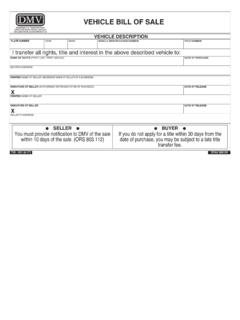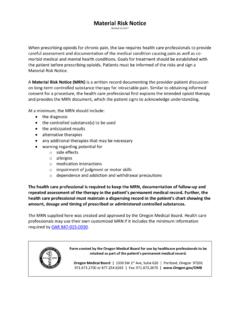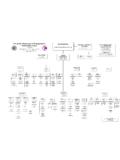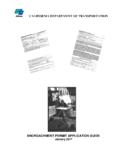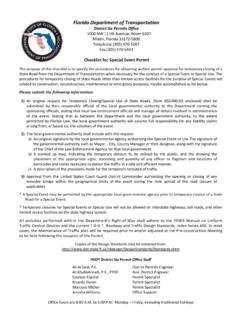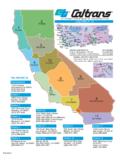Transcription of regon Department of Transportation - oregon.gov
1 Attachment 75A FORM 734-2352 (6-16) STK#202212 Page 1 of 4 SPECIAL Transportation PERMIT ATTACHMENT 75A (REVISED 06-2016) Please read this permit carefully! This permit authorizes the movement of a mobile home, modular building, or chassis unit(s) at the dimensions authorized on the permit and over the approved route. Corrections must be made before the movement begins. Once the permit is accepted, all permit requirements and conditions must be met. To legally operate in oregon , tax and registration requirements must also be met unless otherwise exempt by statute or rule.
2 This Transportation Variance Permit does not authorize your vehicle to operate in oregon in excess of the vehicle's Registration weight or tax declared weight(s). Vehicle(s) must be registered and tax declared at the highest weight(s) appropriate to your operation. Contact ODOT MCTD Registration at (503) 378-6699 for information. Permittee and Driver Responsibility - You are responsible and liable for any and all injury to persons or damage to property and all damage to or destruction of any highway or any highway structure resulting from the oversize or overweight movement. You are responsible for determining adequate clearance, both vertical and horizontal, for movement under this permit. It is the responsibility of the motor carrier to notify the Over-Dimension Permit Unit in the event of striking a structure in the course of a movement within 24 hours of the accident.
3 You are also responsible for contacting public utilities ( telephone, electric, cable, etc.) to determine oversize load clearance. You may be required to furnish proof of liability and property damage insurance and to file either a certified check or a surety bond as deemed necessary. The individual or company to whom the permit is issued must be familiar with all laws and rules applicable for the Transportation of oversize loads or vehicles. Drivers of vehicles towing mobile homes exceeding a base width of 14 feet or an overall width of 15 feet must meet specific requirements as shown in OAR 734-075-0022. The driver is responsible for complying with all applicable oregon laws in addition to all permit requirements and provisions. It is the driver s responsibility to determine if local road conditions are hazardous, unless the Department of Transportation has posted signs on the highway displaying restrictions due to weather/road conditions in the area.
4 In such cases the permitted vehicle must leave the highway at the next available exit, truck stop, rest area, or next available safe parking place and shall not proceed until the hazardous condition abates. Drivers making the wrong choice and continuing to operate when hazardous conditions exist, or who violate any other permit requirement or provision, are subject to citation. In addition, the responsible Motor Carrier is subject to civil monetary complaint on a first offense; and in the instance of repeated violations, is subject to additional sanctions including cancellation of permit and/or denial of future permit requests. Drivers must enter an oregon scale when directed to do so by an open sign. If the vehicle is equipped with a transponder and you are transporting an oversize unit, you must enter the open scale regardless of receiving a green light.
5 This is a brief summary of regulations governing the Transportation of mobile homes and modular building units. For a complete copy of oregon Administrative Rule, Chapter 734, Division 75, contact us at the address shown on this attachment or at our Website: For purposes of this rule, unit means a mobile home, manufactured home or modular building unit. These are units designed for human habitation or for business, commercial, or office purposes and shall be transported with only those items to be a permanent part of the unit or accessory parts. This permit is not valid for vehicles licensed, or which can be used as recreational vehicles as defined by ORS (33), unless specifically authorized on the permit. This permit is valid for the time period specified on the permit. Single trip permits (STPs) are valid for a single move, not to exceed ten days.
6 Continuous trip permits (CTPs) are valid for multiple trips within the time frame specified on the permit not to exceed one year. The Department may cancel a permit if the permit holder violates any permit terms or conditions, obtains it improperly, or if public interest requires cancellation. Legal height in oregon is 14 feet 0 inches and legal width is 8 feet 6 inches. Single trip permits will propose a suggested route that must be followed in the sequence shown on the permit. Actual operation under the authority of a single trip permit will establish that the Permittee has verified the adequacy of the suggested route. Therefore, it is required that the Permittee contact the Over-Dimension Permit Unit to request changes deemed necessary to the suggested route prior to actual operation. The Permittee assumes all liability for any damages resulting from operations under the permit.
7 Continuous trip permits generally are accompanied by route maps displaying routes authorized by the permit. On occasion, some continuous trip permits are route specific and require travel in the sequence suggested on the permit. In those instances it will similarly be required that the Permittee contact the Over-Dimension Permit Unit prior to Department of TransportationMotor Carrier Transportation Division3930 Fairview Industrial Drive SESalem, OR 97302-1166 Telephone (503) 373-0000 FAX (503) 378-2873 oregon Kate Brown, Governor Attachment 75A FORM 734-2352 (6-16) STK#202212 Page 2 of 4 operation if the suggested route is deemed inadequate.
8 Operation under the permit means the Permittee confirms the suggested route is appropriate and the Permittee assumes all liability for any damages resulting from operations under the permit. This permit does not authorize county roads and city streets unless specifically stated on the permit. To operate over these roads or streets, a permit must be obtained from the appropriate county or city. The Salem permit office can obtain approval for single trip permits in most counties. Such approval is noted under Special Provisions on the permit. Highways or structures may be posted to reduce size or weight limits. Drivers shall not exceed posted length or weight limits regardless of the lengths or weights authorized by this permit. This permit does not authorize the use of detour routes unless your permit specifically allows the use of the route at the size and weight of your load and vehicle(s).
9 Detour routes are temporary routes that are established primarily for legal size and legal weight vehicles. You must contact a permit agent and obtain a new permit before continuing your move. Spacing Interval - The convoy movement of two or more vehicles required to display Warning Signs is strictly prohibited, unless specifically authorized on the permit. All slow-moving lanes and turnouts must be used to allow following traffic to pass. Except when overtaking or passing, a distance of one-half mile shall be maintained between combinations traveling in the same direction. The vehicle towing the mobile home must be equipped with dual wheels on the drive axle and shall have enough engine horsepower to maintain minimum speeds of 45 MPH on Interstate highways and 35 MPH on other highways. In addition, the vehicle towing the unit must have a minimum GVWR of: 8,000 pounds when the base width is up to 10 feet or the overall width is up to 11 feet; 15,000 pounds when the base width exceeds 10 feet up to 14 feet or the overall width exceeds 11 feet up to 15 feet; 32,000 pounds when the base width exceeds 14 feet or the overall width exceeds 15 feet.
10 A minimum of two spare tires must be carried for the unit being towed; they are to be inflated and ready for use. The unit length (inclusive of tongue) cannot exceed 80 feet in length. The overall combination length cannot exceed 110 feet. The base width cannot exceed 16 feet, and the overall width cannot exceed 18 feet. A unit may have an eave providing it does not exceed either side by: More than 30 inches for units with a base width of less than 16 feet; More than 16 inches for units with a base width of 16 feet. Note: If the eave extends more than 24 inches beyond either side of the unit, in addition to all other lights required by law, a clearance light as described in ORS shall be mounted on the outermost front and rear corners of the eave. Mobile homes exceeding a base width of 14 feet must: Have a minimum of four axles, except units that do not exceed 40 feet in length may be equipped with three axles; Have brakes that comply with Federal Motor Carrier Safety Regulations (b)(2), provided the combination of vehicles meets the requirement of brake performance.
